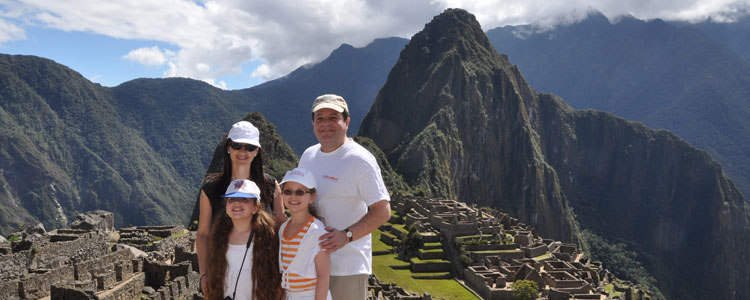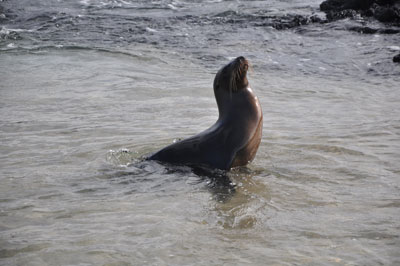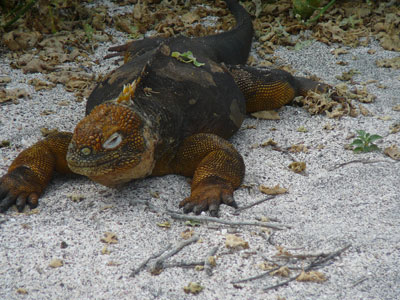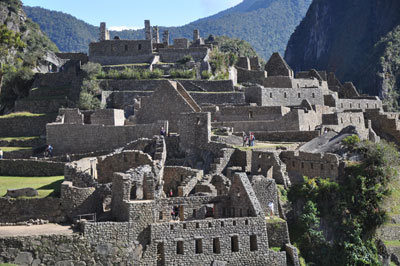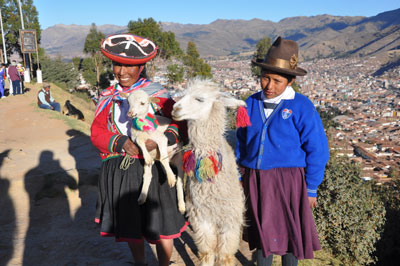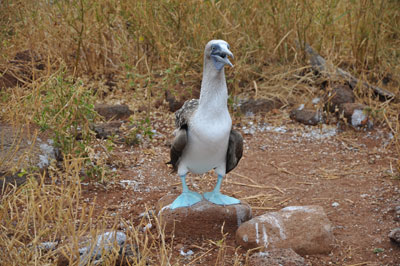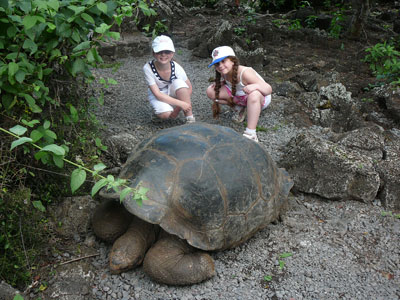Not your average family vacation—taking in the stunning sights of Machu Picchu and the Galápagos Islands
by Evan Goldfischer; Pleasant Valley, NY
In 2010 I took my nine- and seven-year-old daughters on a family trip to East Africa (Jan. ’11, pg. 20). Now that they’ve got the travel bug, I thought it was time for us to tackle Machu Picchu and the Galápagos Islands.
Geographic Expeditions (San Francisco, CA; 800/777-8183) organized our trip, which proved to be more difficult than expected, as we had to build options into the trip in case the children (or the adults, for that matter) could not handle the long hikes or high altitudes.
We knew that we would be taking 11 flights and 39 panga (open-hull boat) rides and staying at seven different locations in under two weeks. At the end of it all, everything had gone well, and we all have some great memories.
The tour cost was $39,571 for the four of us, including cancellation insurance. Flights from the US were an additional expense.
Heading out
We left the US on June 12, 2011, on a connecting Delta flight from LaGuardia Airport to Lima, Peru. The flight was on time, and we arrived in Lima close to midnight. Lima’s airport was surprisingly modern, but our driver was late, as he thought we would take a long time collecting our luggage and completing the Immigration formalities. He did not realize that our family travels with only carry-on bags.
We spent our first night at the Ramada Costa del Sol, located across the street from the terminal. It was not luxurious, in the least, and I would not recommend it for an extended stay, but its location was convenient, as we had an early-morning flight to Cusco.
In the mornings, flights leave Lima for Cusco almost every 30 minutes. In less than one hour, we had landed and were walking around at 11,200 feet. We all felt a bit lightheaded. Our guide, Juan de Dios Castillo, met us at the airport and encouraged us to drink plenty of water and chew on coca leaves or have coca tea. As I didn’t know of any scientific evidence indicating that coca leaves prevent altitude sickness, we stuck with the water.
Cusco is a beautiful colonial city surrounded by magnificent Incan ruins. We visited the Cathedral of Santo Domingo; Coricancha, the Incan Temple of the Sun; the sacred sites of Kenko and Tambomachay, and the fortress of Sacsayhuamán. I was absolutely fascinated by these sites. They are incredibly well preserved, and the architecture is stunning.
We also went to a factory and bought some beautiful alpaca sweaters and gloves. (We had been advised that most of the alpaca products on the street are cheap imitations and not made with any alpaca fleece.) We found the prices to be reasonable, and moderate bargaining (resulting in a 10%-20% discount) was encouraged.
That night we stayed at Hotel Monasterio, part of the luxury Orient-Express chain. The property was an old monastery that had been converted to a hotel and it was absolutely fantastic. It is well located in Cusco (you can walk almost anywhere from there), with beautiful rooms and great service. For an extra fee ($48 per night), they would even pump oxygen into your room!
By the next morning we had adjusted to the altitude. We drove to Písac and Ollantaytambo (8,000-9,000 feet), in the Sacred Valley of the Incas. Písac had a great outdoor market, and Ollantaytambo, one of the few sites where the Spanish were defeated in their conquest of South America, is the best surviving example of a true Incan city in the Cusco region.
The huge, steep terraces surrounding the fortress there proved a valuable defense for the Incas, as they could freely rain arrows and spears down on any enemies climbing up. The children really enjoyed exploring the ruins.
From Ollantaytambo, we took an afternoon train toward Aguas Calientes, where we checked into a nice junior suite at the luxurious Inkaterra Machu Picchu Pueblo Hotel.
Machu Picchu
We rose early the next day to embark with Juan, our guide, on a day of private touring at the archaeological complex of Machu Picchu.
We took a 30-minute bus ride from our hotel to the entrance of the ruins. It is best to go early to beat the crowds and the heat. Inside the actual complex, there are no restrooms and no vendors selling water, so plan accordingly.
Machu Picchu is the best-known Incan site of the modern world, but archaeologists can only speculate on its function. From the fine quality of its stonework, it is assumed that it must have been an important ceremonial center.
We walked through the ruins and did two special hikes. The first, which was not that difficult, was to the old Incan Bridge, while the second hike was entirely uphill to the Gate of the Sun.
We had lunch at the Sanctuary Lodge, the other luxury lodging option there, before taking the Orient-Express’ train Hiram Bingham back to Cusco, with dinner served on board on fine china. A band performed traditional and modern music in the bar car. It was a great ending to the day.
That night, we stayed in Cusco at La Casona, a smaller Inkaterra property located across from Hotel Monasterio. The rooms were great, but it was not ideal for families as there were no connecting rooms.
On to Ecuador
The next day was a complete washout, as the Lan flight from Cusco to Lima was delayed and the agent at the Lima airport was very strict about the 90-minute check-in policy for our flight from Lima to Guayaquil, Ecuador, even though we did not have any bags to check. So, instead of flying nonstop to Guayaquil as scheduled, we had to fly to Quito, then change planes and continue on to Guayaquil. This was supposed to be our rest day, but we spent it on airplanes due to Lan’s inflexibility.
In Guayaquil we stayed near the airport at the Hilton Colon, which had a great pool and nice restaurants. The service there was excellent.
Ecuador uses the American dollar, so we didn’t have to change any money, though there weren’t many tourist sites in Guayaquil, anyway.
We were now ready for the second part of our adventure. We took a 90-minute flight from Guayaquil to San Cristóbal Island. As the Galápagos Islands are a protected national park, there was a lot of security regarding bringing plants or vegetables onto the islands.
We took a short bus ride to the dock, where we were greeted by sea lions basking in the sun. Our first wildlife experience! We donned life jackets and took our first panga ride to our home for the next week, La Pinta.
The 207-foot-long yacht had 24 cabins that could hold up to 48 passengers, all on one deck. Some rooms were triples and some were connecting double cabins, which is what we chose. Although none of the cabins had balconies, they did have large picture windows.
The boat also had a small fitness room, an outdoor Jacuzzi, indoor and outdoor dining rooms and a bar/briefing room. It did not have a spa or laundry service.
There were four naturalists on board who gave us briefings each evening as to what we would see the next day. All of them were Galápagos natives and very well informed.
Island hopping
Our first day was spent around San Cristóbal. After lunch, we took a panga ride along the rocky shoreline of Isla Lobos, a rugged satellite islet of San Cristóbal. It is home to Galápagos sea lions, brown pelicans, marine iguanas and frigatebirds and offers stunning vistas of nearby Kicker Rock.
We had a wet landing on a coralline beach, Playa Ochoa. Highlights ashore included the Chatham mockingbird and the Chatham lava lizard, both species endemic to San Cristóbal and seen nowhere else in the Galápagos.
These were the same shores that Charles Darwin walked upon back in September 1835, as San Cristóbal was the first island on which he set foot in the Galápagos.
That night, in addition to our naturalist briefing, we had a welcome cocktail party with the captain, who invited us to visit the bridge anytime.
Although this was the dry time of year in the Galápagos, we had very few flies or mosquitoes, but the water was colder and our crossings at night were very choppy.
The next morning we had a dry landing on North Seymour Island. We walked about two miles along the coast and saw colonies of blue-footed boobies, frigatebirds, with their big puffed-out red breasts, and swallow-tailed gulls plus sea lions and marine iguanas. We then went back to the ship, put on our wetsuits and went snorkeling.
In the afternoon, we visited Cerro Dragon on Santa Cruz Island and saw a booming iguana colony. As there are no natural predators there, all of the animals, including the iguanas, held their ground and did not mind as we tiptoed around them.
The next morning was a special treat as we stopped at Post Office Bay on Floreana Island and participated in an old whaling tradition. After a wet landing, we walked to an old barrel and each took several letters that we promised to hand deliver or mail when we got home.
We also deposited several letters. No stamps are required, and, believe it or not, the system works! I got my letter in less than a week.
We then did some snorkeling around Champion Islet, followed by lunch and a siesta while the ship repositioned itself along Punta Cormorant, where we viewed flamingos, then went on another snorkeling excursion.
The next day presented our most strenuous adventure. We had a dry landing at Punta Moreno on Isabela Island and walked over some very sharp pahoehoe lava that stretched to the foot of some of the most active volcanoes in the Galápagos, Cerro Azul and Volcán Santo Tomás (aka Sierra Negra). The landscape was briefly interrupted by scattered small, brackish lagoons, one of which contained several reef sharks.
After lunch we visited Punta Espinoza on Fernandina Island. It is the youngest island in the Galápagos, and during our one-mile trek we saw marine iguanas, Sally Lightfoot crabs, hawks, penguins and the flightless cormorant.
Wonderland of wildlife
In the morning we visited one of the inhabited islands in the Galápagos. We drove to the highlands of Santa Cruz Island to see a Scalesia forest and the twin craters of Los Gemelos. We also donned mud boots and took a one-mile walk along a trail to see giant tortoises in the wild.
We had lunch at the Finch Bay Eco-Hotel, where there was an opportunity to have laundry done and to check e-mail. We then went to the Charles Darwin Research Station to see baby tortoises and the famous Lonesome George, the last of his subspecies. (Scientists have been unable to breed him.) Finally, we visited the town of Puerto Ayora for some souvenir shopping.
The next day we visited Bartolomé Island, which was really fun. A small satellite island of the neighboring Santiago Island, it is a landmark of the Galápagos.
We climbed a long, wooden staircase to the summit of Pinnacle Rock and took some great photos. After our descent, we went snorkeling in the turquoise water with Galápagos penguins and chocolate chip sea stars.
During lunch, we sailed the short distance to Rábida Island for an easy stroll to see Darwin finches and to snorkel with the sea lions.
The kids had the best time at Gardner Bay, which is home to hundreds of sea lions. We walked freely amongst them and played with them in the surf. In the afternoon we had a dry landing on Punta Suárez on Española Island, where we took a long walk over rocks and lava and saw waved albatrosses (with their huge wingspans), colonies of Nazca and blue-footed boobies, swallow-tailed gulls and the island’s famous blowhole.
The next morning, our cruise came to an end where it had begun, but we had one more stop, at La Galapaguera, seeing deciduous forests, land birds and endemic plants and getting a final view of the Galápagos giant tortoise. We then flew to Guayaquil and on to Quito, where we stayed at the very nice Swissôtel, dining at their excellent Japanese restaurant.
The following morning our guide picked us up for the 1½-hour drive north to the volcanic highlands. We drove through the rural townships of Calderón, Guayllabamba and Cayambe and had lunch at Hacienda Pinsaquí.
The hacienda was originally built in 1790, then was rebuilt in the same style after a violent earthquake in 1867. Set beneath the green peaks of the highland volcanoes, Pinsaquí is an authentic and lavish colonial hacienda with ornate beds in the main house; chandeliers; sunny corridors, and 200-year-old gardens, complete with a garden pond.
This hacienda has belonged to the same family since 1888 and was the locale of major historical events, such as the signing of the treaty between Ecuador and Colombia that established friendship between the two countries.
The highlight of the day was an afternoon visit to the famous Otavalo market, piled high with ponchos, woolen goods, tapestries, the original “Panama” hat, sweaters, Indian jewelry and handicrafts. This market town has grown throughout the years to become one of the most colorful, thriving and well-known indigenous markets in the Andes. It was a great place to buy our last-minute gifts and souvenirs.
That night we went back to our hotel for dinner, then took an overnight Delta flight back home.
Overall, this was an amazing family trip. We have great stories to tell and phenomenal photos to show our friends.

